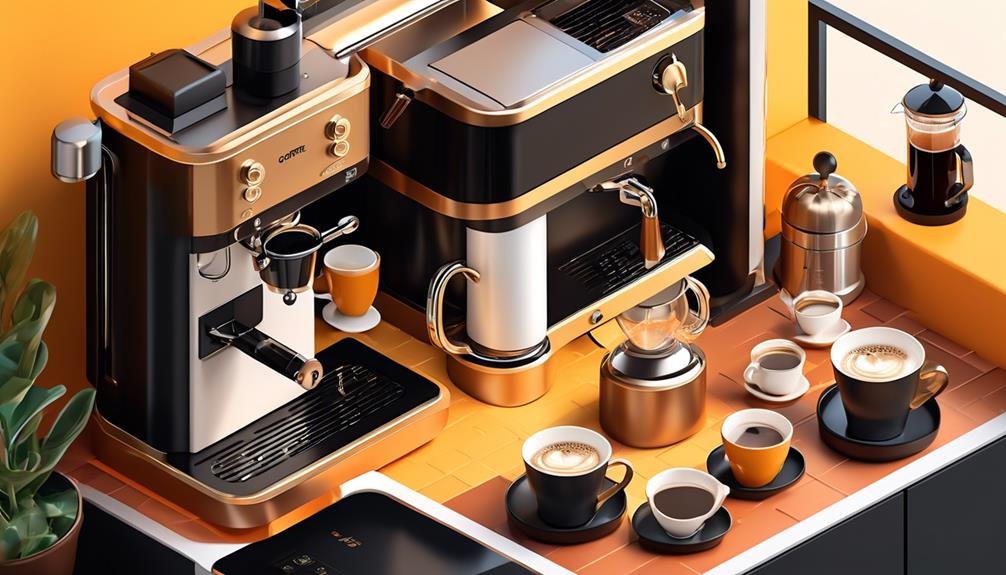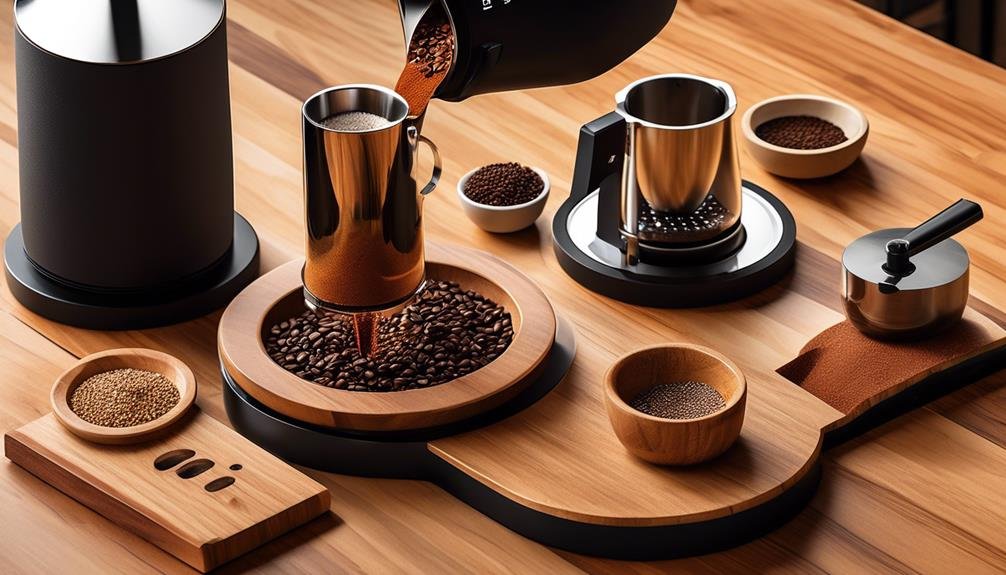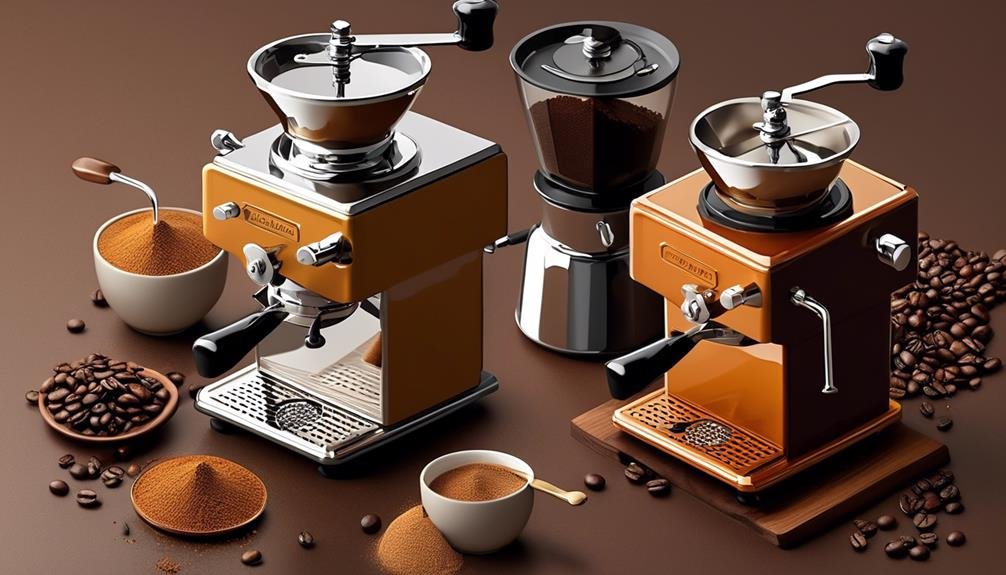You've probably heard the saying, 'There's more than one way to skin a cat.' Well, when it comes to brewing coffee, there's more than one way to grind your beans.
But have you ever wondered what sets drip grind apart from espresso grind? What is it about the size of the grind that affects the flavor extraction?
In this discussion, we'll explore the key differences between drip and espresso grind sizes, and how they impact your coffee experience.
So grab a cup of your favorite brew and get ready to uncover the secrets behind the perfect grind.
Key Takeaways
- Grind size affects extraction rate and flavor profile in coffee.
- Medium grind size is recommended for drip coffee, while espresso requires a much finer grind size.
- Incorrect grind size can result in a weak or bitter taste.
- Consistency in grind size is important for balanced flavor extraction.
Understanding Grind Size Basics
To understand the basics of grind size, you need to know how it affects the flavor of your coffee. Grind size refers to the size of the coffee particles after grinding. It plays a crucial role in determining the extraction rate and flavor profile of your brew.
When it comes to drip coffee, a medium grind size is typically recommended. This grind size allows for a balanced extraction, resulting in a flavorful cup with medium body.
On the other hand, espresso requires a much finer grind size. The fine particles ensure a quick extraction, producing a concentrated and intense shot of coffee. If the grind size is too coarse, the water will pass through too quickly, resulting in a weak and under-extracted espresso. Conversely, if the grind size is too fine, the water will struggle to pass through, leading to over-extraction and a bitter taste.
Understanding the appropriate grind size for each brewing method is crucial in achieving the desired flavor and strength in your coffee.
Drip Grind Size Explained
When it comes to brewing drip coffee, understanding the appropriate grind size is essential for achieving the desired flavor and strength in your cup. Here's a breakdown of drip grind size and why it matters:
- Medium grind: This is the most commonly recommended grind size for drip coffee. It resembles granulated sugar and is ideal for automatic drip coffee makers. The medium grind allows water to flow through the grounds at a moderate pace, extracting the flavors evenly.
- Coarse grind: If you prefer a stronger cup of coffee, a coarse grind might be the way to go. This grind size is similar to sea salt and is often used in manual drip methods like pour-over or French press. The slower water flow allows for a more robust extraction.
- Fine grind: On the other end of the spectrum, a fine grind is used for a quicker extraction and a more intense flavor. This grind size is commonly used in espresso machines, but it can also be used in some drip coffee makers. However, be cautious as a fine grind can lead to over-extraction and bitterness.
Understanding the appropriate grind size for your drip coffee can make a significant difference in the taste and strength of your brew. Experimenting with different grind sizes allows you to personalize your coffee experience and find the perfect cup for your preferences.
Espresso Grind Size Explained

The appropriate grind size for espresso is crucial in achieving a balanced and flavorful shot of coffee. Unlike drip coffee, which requires a coarser grind, espresso calls for a much finer grind size. This is because the water is forced through the coffee grounds at high pressure and in a short amount of time.
A fine grind size ensures that the water extracts the flavors from the coffee quickly and efficiently, resulting in a concentrated and rich shot. If the grind size is too coarse, the water will flow through too quickly and the shot will be weak and watery. On the other hand, if the grind size is too fine, the water will struggle to pass through the compacted coffee, leading to over-extraction and a bitter taste.
To achieve the ideal espresso grind size, you need a good quality burr grinder that allows for precise adjustments. Experimentation is key to finding the perfect grind size for your taste preferences, as different beans and machines may require slight variations.
How Grind Size Affects Flavor Extraction
Achieving the ideal espresso grind size isn't only crucial for a balanced and flavorful shot, but it also plays a significant role in how the flavors are extracted from the coffee.
The grind size affects flavor extraction in the following ways:
- Surface Area: The grind size determines the amount of surface area exposed to water during the brewing process. Finer grind sizes have a larger surface area, allowing for a more efficient extraction of flavors. Coarser grind sizes, on the other hand, have a smaller surface area, resulting in a slower extraction process and potentially weaker flavors.
- Extraction Rate: The grind size also affects the rate at which flavors are extracted. Finer grind sizes extract flavors more quickly, while coarser grind sizes extract flavors at a slower pace. This difference in extraction rate can impact the balance and intensity of flavors in the final cup.
- Extraction Uniformity: The grind size determines how evenly the flavors are extracted from the coffee grounds. If the grind size is inconsistent, some particles may extract more quickly than others, leading to an uneven flavor profile. Consistency in grind size ensures a more uniform extraction and a more balanced flavor.
Understanding how grind size affects flavor extraction can help you achieve the desired flavor profile in your espresso shot. Experimenting with different grind sizes allows you to fine-tune the extraction process and discover the perfect balance of flavors for your taste preferences.
Brewing Methods for Drip Grind

To brew drip coffee with a fine grind size, you can consider using various brewing methods. These methods will ensure that you achieve the perfect balance of flavors and aromas in your cup of coffee. Here are four popular brewing methods that work well with a drip grind:
| Brewing Method | Description | Pros | Cons |
|---|---|---|---|
| Pour Over | Hot water is poured over coffee grounds in a filter cone. | Clean and bright flavors | Requires a steady hand and practice |
| Automatic Drip | Water drips through a filter containing coffee grounds. | Convenient and easy to use | Limited control over extraction process |
| French Press | Coffee grounds steep in hot water before being pressed down. | Full-bodied and rich flavors | Sediment may end up in the final cup |
| Aeropress | A plunger is used to create pressure and extract coffee flavors. | Quick and versatile brewing | Requires additional equipment |
Each brewing method offers a unique way to extract flavors from the fine grind size. Whether you prefer the control of a pour-over, the convenience of an automatic drip, the robustness of a French press, or the versatility of an Aeropress, you can experiment with different methods to find the one that suits your taste preferences. Remember to adjust the brewing time and water temperature accordingly to achieve the best results with your chosen method.
Brewing Methods for Espresso Grind
Now let's explore the brewing methods that are ideal for extracting flavors from the espresso grind size. When it comes to brewing espresso, the following methods can help you achieve the best results:
- Espresso Machine: This is the most common method used to brew espresso. With an espresso machine, hot water is forced through the finely ground coffee under high pressure, resulting in a concentrated and flavorful shot of espresso.
- Moka Pot: A moka pot is a stovetop coffee maker that uses steam pressure to brew espresso-like coffee. It works by heating water in the bottom chamber, which then creates steam that pushes the water through the coffee grounds and into the upper chamber.
- Aeropress: The Aeropress is a versatile and compact device that uses air pressure to brew espresso-style coffee. It works by placing coffee grounds in a chamber, adding hot water, and then using a plunger to create pressure and extract the flavors.
Choosing the Right Grind Size for Your Brewing Method

The key to achieving the perfect cup of coffee lies in selecting the appropriate grind size for your brewing method. The grind size determines how quickly water can extract the flavors from the coffee grounds, so it's crucial to get it right.
For drip brewing methods, such as pour-over or automatic drip machines, a medium grind size is generally recommended. This allows for a balanced extraction and ensures that the water flows through the coffee evenly.
On the other hand, for espresso brewing, a finer grind size is necessary. Espresso machines use pressure to extract the coffee flavors, so a finer grind allows for a quicker and more efficient extraction.
It's important to note that different brewing methods may require slight adjustments in grind size to achieve the desired flavor profile. Experimentation and tasting will help you find the perfect grind size for your preferred brewing method.
Experimenting With Grind Sizes for Optimal Coffee Taste
For optimal coffee taste, it's essential to experiment with different grind sizes. Finding the right grind size can significantly impact the flavor and aroma of your coffee.
Here are three reasons why experimenting with grind sizes is important:
- Extraction: The grind size affects how quickly water passes through the coffee grounds. Finer grinds extract more flavor compounds quickly, while coarser grinds require more time for extraction. By adjusting the grind size, you can control the extraction process and achieve the desired flavor profile.
- Balance: Different brewing methods and coffee beans require different grind sizes to achieve balance in the cup. For example, espresso calls for a fine grind to extract the intense flavors, while drip brewing requires a medium grind for a well-rounded taste. Experimenting with grind sizes allows you to find the perfect balance for your preferred brewing method.
- Consistency: Consistency is key to brewing a great cup of coffee. By experimenting with grind sizes, you can ensure that each cup you make is consistent in flavor, strength, and extraction. This consistency will help you refine your brewing technique and produce consistently delicious coffee.
Frequently Asked Questions
How Does the Grind Size Affect the Brewing Time for Drip Coffee?
The grind size affects the brewing time for drip coffee. Finer grinds extract faster, resulting in a shorter brewing time. Coarser grinds take longer to extract, leading to a longer brewing time. Adjusting the grind size allows you to control the brewing time for your desired taste.
Can I Use an Espresso Grind Size for a Drip Coffee Maker?
You can use an espresso grind size for a drip coffee maker, but it may result in over-extraction and a bitter taste. It's best to use a coarser grind for drip coffee to achieve optimal flavor.
What Is the Best Brewing Method for a Medium Grind Size?
For a medium grind size, the best brewing method would be a drip coffee maker. It allows for a balanced extraction and produces a clean, smooth cup of coffee.
Does the Grind Size Affect the Intensity of the Coffee Flavor?
Yes, the grind size does affect the intensity of the coffee flavor. Finer grinds, like espresso, extract more flavor and have a stronger taste. Coarser grinds, like drip, result in a milder flavor.
Can I Use a Blade Grinder to Achieve a Consistent Grind Size for Espresso?
Yes, you can use a blade grinder for espresso, but it may not produce a consistent grind size. Blade grinders tend to create uneven particles, which can impact the quality of your espresso extraction.
Conclusion
In conclusion, understanding the difference between drip and espresso grind sizes is crucial for achieving optimal coffee taste.
Drip grind size is coarser and ideal for brewing methods like pour-over and automatic drip machines.
On the other hand, espresso grind size is finer and suited for espresso machines.
The right grind size greatly affects flavor extraction, so it's important to choose the appropriate grind size for your brewing method.
Experimenting with different grind sizes will help you find the perfect balance for your coffee.




